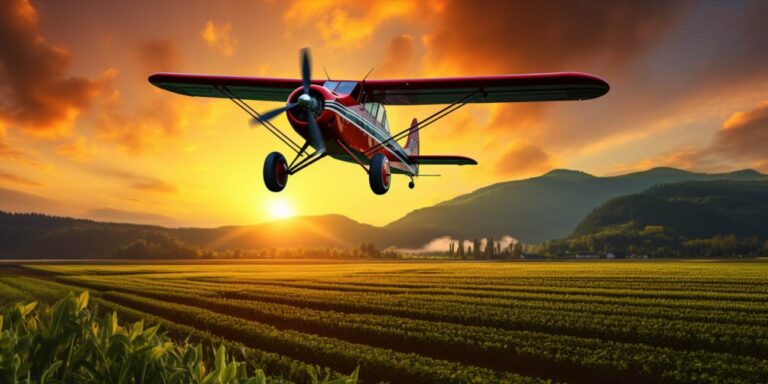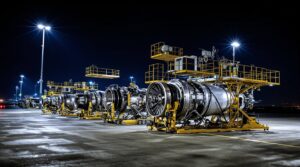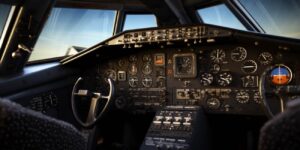The key to this ballet is the principle of lift. Imagine the wing as a performer, and lift as the applause from the air. As the aircraft moves forward, the wing slices through the air, creating a pressure difference between its upper and lower surfaces. This pressure disparity is the crux of how an aircraft wing generates lift.
Picture the airfoil, the wing’s cross-sectional shape, as a cunning sorcerer manipulating air molecules. The upper surface is curved, encouraging faster airflow, while the lower surface is relatively flat, allowing air to linger. This results in lower pressure above and higher pressure below, a Bernoulli’s principle enchantment.
The angle of attack, akin to a magician’s wand, plays a crucial role. It is the angle between the chord line (a line from the leading edge to the trailing edge) of the wing and the oncoming air. A delicate balance must be maintained, for too steep an angle can stall the wing, disrupting the spell of lift.
Now, let’s add a touch of complexity with flaps and slats. These are movable surfaces on the wing’s trailing and leading edges, respectively. Deploying them alters the wing’s shape, enhancing lift during takeoff and reducing speed during landing, a choreography of adaptation.
As we delve deeper, the wing span becomes a noteworthy protagonist. The longer the wingspan, the more room for the magic of lift to unfold. This is particularly evident in soaring birds, masters of the sky with their extensive wingspans.
It’s fascinating to note that even in straight and level flight, gravity is ever-present, seeking to pull the aircraft back to Earth. However, the wing, with its mastery of lift, maintains equilibrium, a celestial tug of war where flight prevails.
Now, envision the aircraft wing as a multifaceted artist, not only conjuring lift but also battling the forces of drag. Drag, the antagonist in this aviation narrative, is the resistance the wing encounters as it cleaves through the air. Streamlining, represented by the wing’s sleek design, is the hero countering this force.
As we unravel the intricacies of how an aircraft wing works, the harmony of engineering, physics, and sheer ingenuity becomes apparent. It’s a testament to human mastery over the skies, a ballet where the dancers are made of metal and composites, and the choreography is written in equations and aerodynamic principles.
The cross-sectional shape of an aircraft wing and how it impacts lift
The cross-sectional shape of an aircraft wing plays a crucial role in determining its aerodynamic performance, particularly in generating lift. Engineers and aerodynamicists delve into the intricacies of wing design to optimize the shape for various aircraft, taking into account factors such as speed, altitude, and the aircraft’s intended purpose.
One of the primary considerations is the choice between a symmetric and a cambered wing profile. A symmetric wing, as the name suggests, has an identical shape on the top and bottom surfaces. This design is often seen in aerobatic or high-speed aircraft, as it provides predictable behavior during maneuvers. On the other hand, a cambered wing has a curved shape, with the upper surface being more convex than the lower surface. This design is prevalent in commercial aircraft, where the emphasis is on efficiency and lift generation at lower speeds.
The angle of attack, which is the angle between the chord line (an imaginary line between the leading and trailing edges of the wing) and the oncoming air, is another critical factor. A moderate angle of attack is often optimal for generating lift efficiently. However, excessive angles can lead to stalling, where the smooth flow of air over the wing is disrupted, resulting in a sudden loss of lift.
Wing designers also consider the aspect ratio, which is the ratio of the wing’s span to its average chord. A higher aspect ratio, achieved through longer wings, generally results in lower induced drag and improved lift-to-drag ratio. This is advantageous for aircraft that need to operate efficiently over a wide range of speeds.
Furthermore, the presence of winglets deserves attention. Winglets are small, upturned extensions at the wingtips designed to reduce the aerodynamic drag caused by wingtip vortices. They contribute to fuel efficiency by improving the overall aerodynamics of the wing.
It’s essential to highlight the impact of these design choices on the aircraft’s performance. The right combination of wing shape, angle of attack, and other factors can lead to enhanced lift, fuel efficiency, and overall stability. Aircraft manufacturers invest significant resources in research and testing to fine-tune these parameters, seeking the optimal balance for each specific model.
The angle of attack of an aircraft wing and its role in producing lift
The angle of attack of an aircraft wing is a critical parameter that plays a pivotal role in determining its aerodynamic performance. It refers to the angle between the chord line of the wing and the oncoming air. This seemingly subtle parameter is the linchpin in the ballet of flight, orchestrating the delicate balance between lift, stall, and the chaotic dance of turbulence.
When the aircraft is in level flight, the angle of attack is typically modest, allowing for a harmonious interaction with the air. As the angle of attack increases, so does the lift generated by the wing. This is the magic of aviation, where the manipulation of angles transforms a heavy metal bird into a graceful entity defying gravity. Pilots skillfully adjust the angle of attack to control altitude and maintain equilibrium.
However, the enchanting waltz between the wing and the air can quickly turn into a turbulent tango if pushed beyond limits. Stall, the ominous term in aviation parlance, is the result of exceeding the critical angle of attack. It’s like a misstep in the dance, where the wing abruptly loses its lift-producing charm. The airflow over the wing becomes disrupted, leading to a sudden drop in lift, and the aircraft starts to descend uncontrollably.
Imagine the wing as a performer on a stage; a stall is akin to a stumble. Recovery from a stall involves reducing the angle of attack and restoring the delicate choreography between the wing and the air. Pilots are trained to recognize and respond to these critical moments, ensuring the dance continues without a tragic finale.
Conversely, playing with the angle of attack can also create a mesmerizing spectacle known as a vortex. As the wing slices through the air, it leaves behind swirling vortices at its tips. These ethereal spirals are the remnants of the air’s encounter with the wing’s pressure difference. While visually captivating, encountering these vortices can be a turbulent affair for nearby aircraft, potentially inducing unwanted disturbances.
Understanding the delicate interplay of the angle of attack is essential for aviation professionals. It’s a delicate dance between generating enough lift for flight and avoiding the perilous pitfall of a stall. As the wing pirouettes through the sky, leaving behind vortices in its wake, the complexities of aerodynamics reveal themselves, reminding us that the art of flight is a symphony of angles and airflow.
How the curved surface of an aircraft wing helps create airflow differences
The curved surface of an aircraft wing is not just a sleek design choice; it plays a crucial role in manipulating airflow to enhance aerodynamic performance. The intricacies lie in how this curvature influences the boundary layer, creates circulation, and manages downwash.
As an aircraft moves through the air, the wing’s curved surface serves as a masterful conductor, orchestrating the flow of air around it. The boundary layer, a thin layer of air in close proximity to the wing’s surface, is directly impacted. This layer experiences a change in velocity and pressure due to the curvature, affecting the overall aerodynamic behavior of the wing.
The curvature induces variations in air pressure along the wing’s surface, causing the air above the wing to travel faster than the air beneath it. This discrepancy in speed results in a pressure difference, generating a force known as circulation. This phenomenon is fundamental to lift generation, a vital factor in the aircraft’s ability to defy gravity and stay airborne.
Picture the wing as a conductor of an airflow symphony, where the circulation is the harmonious melody that enables flight. The carefully designed curvature ensures that this melody plays out optimally, enhancing the lift force by manipulating the pressure distribution over the wing.
Now, let’s delve into the downwash effect. As air circulates around the wing, it creates a downward flow behind the trailing edge. This downward motion is the downwash, a consequence of the circulation phenomenon. Managing downwash is crucial for stability and control, as it influences the aircraft’s pitch and overall handling.
Imagine the downwash as the aftermath of a captivating performance; the audience (airflow) is gently directed downwards as the curtain falls (trailing edge of the wing). Engineers meticulously design wing shapes to optimize this downwash, ensuring stability without compromising lift.






